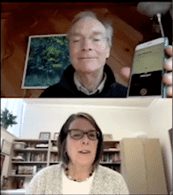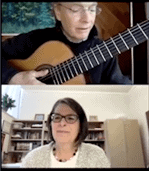The Unspoken Side of Team Creativity
What Two Musicians Are Actually Thinking and Feeling as They Write a Song Together
By NAfME Members Jody Kerchner and Malcolm Brooks
Jody Kerchner and Malcolm Brooks presented on “DocSongs: Composing Their Songs” during the NAfME 2021 PreK–12 Learning Collaborative in February 2021.
In 2021, Jody Kerchner and Malcolm Brooks recorded a Documentary Songwriting session for the NAfME 2021 conference. A documentary song, or docsong, is a collaboratively constructed song that comes from a person’s spoken words about an actual, lived experience. The song documents the emotions of the experience through music.

Furthermore, the process of song creation fosters empathy, enhances self-esteem, and builds community among collaborative group members. In the NAfME video, Jody recounts a personal experience. Then they follow the steps through the documentary songwriting process.
What were the two of them thinking and feeling as they travelled the steps together toward a finished song?
Here are their thoughts and feelings at each of the seven steps of the DocSong process, unvoiced at the time of the videotaping.
Draw Forth a Story (Step 1)
 Jody: I did this once before, and I remember initially feeling like an imposter. After all, I am a conservatory professor and classically trained musician, yet I have never composed nor improvised anything. I don’t want to appear foolish or unmusical in front of a peer. Is this how my students feel when I ask them to try something new? Here we go again into the DocSong process. I know more of what to expect.
Jody: I did this once before, and I remember initially feeling like an imposter. After all, I am a conservatory professor and classically trained musician, yet I have never composed nor improvised anything. I don’t want to appear foolish or unmusical in front of a peer. Is this how my students feel when I ask them to try something new? Here we go again into the DocSong process. I know more of what to expect.
My story is just that: my story that is important to me, but perhaps not meaningful to anyone else. I love telling the story about my grandfather’s and my final days together, singing together and enjoying each other’s company. Is this “song-worthy,” though? What if the song turns out not to be as meaningful as the story feels to me? I’ll need to think about how to guide my students in finding and telling their stories, especially finding ones with emotional attachments. That vulnerability might feel uncomfortable.
 Malcolm: I know Jody will tell a moving personal story, since I’ve worked with her before. But will there be a theme, a phrase, something we can use as a refrain? I’m typing as fast as I can, trying to capture her very words, but I can’t get them all. Hope I won’t miss something that she feels is critical. And will her story be something that other people can grasp and feel? Will we end up with something that will speak to NAfME session participants?
Malcolm: I know Jody will tell a moving personal story, since I’ve worked with her before. But will there be a theme, a phrase, something we can use as a refrain? I’m typing as fast as I can, trying to capture her very words, but I can’t get them all. Hope I won’t miss something that she feels is critical. And will her story be something that other people can grasp and feel? Will we end up with something that will speak to NAfME session participants?
Thinking as I type. We have a setting, that’s good. The word “hospital” could be tough to sing . . . Jody takes action, so something is happening, that’s good. And she says it’s something in her heart, so we have emotion. She says people gather to listen! And here’s a man who’s dying, who’s performing and singing with a smile. The last time Jody saw him, so this is an important, precious time.
Distill into a Free Verse Poem (Step 2)
Jody: There, I’ve told my story. I’m now considered the “story source,” according to the DocSong process. I said a lot of words, which is typical since I hadn’t pre-planned the actual telling of my story. There are some key words and phrases that just must remain in my free verse, that will ultimately be transformed into my song. Malcolm prompts me to keep certain words that he thinks are important. Maybe they will be valuable in terms of telling the story. Not certain about what words I want versus what words I will need in the song construction.
Ah, the form of the free verse is taking shape. It actually flows nicely, with Malcolm’s asking me questions and providing his experienced opinion. When can we get to the music part? In guiding my students in this process, it is important to remind them that the “story source” person has the final say in what stays and what goes from the free verse poem. It will be important to pose questions to the students like, “Why do you think this word or sentence is important to keep? How does the story change if we delete these words? How do we set the context for the action?”
Malcolm: Not sure at this point what the name of this song will be. Have to trust the process. I have a sense of the message, hope those lines get chosen. I’m glad Jody doesn’t hesitate here, or that she doesn’t choose every single word! She chooses “People were at the door listening”—great, such a strong image. Same with, “On his face was an expression of joy and peace . . . ” Hmm . . . how does joy appear on a face? We may have to explore some here to fill the image in, but on the other hand, maybe listeners will imagine it without more details.
What’s missing? We haven’t highlighted the word “grandfather,” because Jody and I already know the story’s about him, but we haven’t made sure it’s included in the poem. An easy fix.
First pass complete. Too many words . . . thank goodness Jody is willing to highlight again and trim what we have.
Now breaking up the long text into lines like a poem . . . No hesitation here again  Jody is decisive about where the lines should end. She’s making the lines short . . . good . . . They’ll be feasible to sing.
Jody is decisive about where the lines should end. She’s making the lines short . . . good . . . They’ll be feasible to sing.
Shape into Lyrics (Step 3)
Jody: Now that we’ve whittled away some of the extraneous words of my initial story, Malcolm and I determine what constitutes a “line” of the song lyrics, one that is not too short nor too long. It’s beginning to look like a poem, grouping lines together that seem to belong together. Malcolm asks the question that guides my wonderment: “Jody, what line of text has a strong emotional expression or is the crux of the story or that you would want repeated throughout the song?” Just looking at the text, I was uncertain, so I returned to the full story and placed myself back into the story to find what was the “punch line” of my story. And it was this image of my grandfather: “On his face was joy and peace and being alive.” It was so clear to me that that was the kernel I wanted repeated—the essence of my experience to which I ascribed emotion and meaning. I like that Malcolm is really listening to my words as they are being spoken. I think all of my students would have a story to share and would relish in having others listen with empathy to their narratives embodied with emotion.
Malcolm: Feeling good—the episodes are clear, Jody separates them easily into verses. She is already thinking that “On his face was an expression of joy and peace and being alive” might deserve to be repeated. Could be a refrain, if we shorten it a bit.
Uh-oh . . . She’s expressed a desire to edit and reword at this point. Have to ask her to postpone.
Uh-oh again, she’s made a reference to Stephen Sondheim and the phrase “being alive.” I don’t know the song that she’s talking about. Will the phrase “being alive” make everyone think of a Sondheim song and take them out of Jody’s world with her grandfather in the hospital? Well, let’s hope if I don’t know the song “Being Alive,” maybe it’s not that well known. We’ll see if this pops up as a concern later. I tell Jody that he wasn’t the first to use the phrase, in any case.
Ok, now it’s time for tidying up. Editing time. Jody says to take out the word “expression.” The refrain is shorter and clearer. The other edits are easy, we concur on everything.
I feel that, for singability, the word “and” should be added, to make the line “joy and peace and being alive.” Grammatically this isn’t conventional, but I feel it and propose it. She’s okay with it.
Design a Melody for One Verse and a Refrain (Step 4)
Jody: Oh, here we go. The moment when it’s time to add a melody to the lyrics. Here I am, the video is rolling, and I am trying to demonstrate for others what I’m uncomfortable doing (at this point of my musical development). Malcolm asks me to sing something, anything, without judgment or editing. He gives me hints as to how a melody could be constructed and shaped. I’m making this way too complicated, I think. I’m looking for the right melody. But there are many possibilities.
Is that the challenge here? I need to slow down and just sing. Malcolm records what I sing. Then he asks for another version, and another. He asks me to sing the first version. Are you kidding me? I can’t remember anything. All the versions flow together. He plays the recording of my singing the first verse. Hey, not bad! He even tells me that there’s a lot of musical material to use. Really? This process feels a bit like a tennis volley. I sing something, Malcolm comments or sings it back to me. I try to remember to sing it and move on with the verse.
Each version is a subtle variation instead of an exact replication. I want it to be exact, yet collaboratively, the song sounds even better with the variations that emerge. My students will need to be reminded that this portion of the DocSong process is difficult, even frustrating at times, yet no one is alone in the process. Malcolm was my song guide. I could relax. How will I be a song guide for my students? How will I mentor group song-guides within collaborative groups, so they demonstrate deep listening, patience, and empathy? How might I guide their melodic decision-making so that we can discuss the possibilities for melodies? What music listening examples might I use to illustrate melodic contour and rhythm?
Malcolm: Sometimes the story source feels more comfortable singing if they know what they want for the arc of the melody. I give a few examples of melodic arcs. Jody suggests that the high point of this melody should be the last line, “being alive.” I see her thinking, but we’ll have to be careful not to make this sound too theatrical. Let’s see what happens.
Jody’s first sing-through is good, but there are too many ideas, making it hard to remember. I hope she’s okay with simplification. I ask her to choose one idea to repeat. She’s game for this. She chooses the melody of the second line.
I sing it back to her for verification and make a mistake. I sing the last note too low. Jody thinks it’s a suggestion, but I didn’t mean that. I tell her fast.
Now we have a mismatch in length of lines. Too many words in the first line, or too few notes in the hospital. The hospital line is essential—can’t take that out. Jody feels there has to be some inserted notes for “in the hospital.” I think she’s right. She sings something in the middle range of the current melody.
I wonder whether this spot is a chance to help ground the listener in the key of the song. If the melody comes back down again, it also sets up a nice leap into the next line, “I thought maybe we could sing.” I sing this extremely simple suggestion to Jody. I notice that I mess up a note towards the end. Darn. I had been concentrating on the first part of her melody and had assumed that I would recall the rest. Jody is kind enough to say nothing. She likes the overall idea. But she points out that if we insert extra notes in the first line in order to match the words, then we have to add extra words to the second line to match the melody. She’s right.
She starts suggesting some words that occur to her. I propose that we consult the original spoken text. Maybe there’s a phrase we can use. It turns out the words “I guess” preceded “I just wanted to sing with him.” Jody tries inserting “I guess” into the melody. Those words are shorter than “in the hospital” but they fit closely enough that I feel confident that we’re in the ballpark. As we sing the song over and over at a later time, ideas will occur to make the lines balance in meter.
It’s time to address the simmering question in my mind: Where’s the groove? I shift us into this area by saying that I’m a rhythmic guy and I crave a pulse. Jody says, “How about this?” and sings our verse lines. But I still can’t figure out the groove. I ask her to clap. She does so, but the groove is still elusive. It could be that the internet is lagging transmission and confusing things. I decide that I should try to interpret her pulse and sing and tap back to her.
Jody understands immediately my effort. She echoes back my echo and claps at the same rate. There’s a groove and a melody. I am feeling really good.
But time is running out, as Jody has observed. I decide to go for the whole verse and refrain. I ask her to sing the first lines and then keep going and see what happens.
Well, we’re golden. The way she sings “on his face” is delicate, intimate, and accessible. She sings something after it there I can’t quite follow. I propose that we simply repeat the melody of “on his face.” I demonstrate, and she agrees, and we have ourselves a melody that we both can sing and remember.
I think to myself that our original plan was to have “being alive” be the high point. It turns out that our final melody ends low instead. No need to mention this, because Jody likes what we have. Me, too.
Edit the Remaining Verses to Fit the Melody (Step 5)
Jody: I need to move the process along. We’re running out of time in our NAfME video. I will suggest we skip over doing the other verses to fit the melody. I think people will understand the process for subsequent verses by listening to and experiencing the melodic construction for the first verse and refrain.
Malcolm: She’s right.
Choose Chords (Step 6)
Jody: This is a lot to demonstrate in one 50-minute video recording! The DocSong processes that I experienced on two other occasions took several hours over the course of several days or over six hours in a one-day workshop. I see Malcolm has his guitar and his voice recorder on his phone. I hope he has ideas regarding song genre and style. I think I would like to see this as an upbeat, folksy accompaniment, maybe with sparse strumming during the refrain—maybe one strum per measure?
I wish I had an instrument to work with, too, so that I could experiment with sounds that I might like to add to the accompaniment. Then again, is a chordal accompaniment necessary? Could it be something rhythmic? Electronic? Sounds of nature? Other? The sky is the limit here. Looking forward to hearing Malcolm’s suggestions.
Malcolm: I explain that I’m only going to use solely the I, IV, and V chords. I figure out that we’re in G. I use the strategy of staying on the I chord until Jody feels the chord should change. I don’t do a perfect job; I switch chords at one point and Jody catches me. She takes the ball and tells me where the chords should change. I am following her, and I’m feeling fine.
Make a Live Recording (Step 7)
Jody: The moment of truth has arrived. Show time! This collaborative song is the manifestation of bringing my story into song. Therefore, I am the co-performer, co-composer, and audience member. It still surprises me to realize that I could generate musical ideas. For so long, I’ve relied on performing someone else’s compositions. We sang (yes, even on Zoom!), and we recorded.
I’m quite proud to hear my narrative transformed into song. There’s still work to be done, since we performed only the first verse and refrain, but the general framework is there. I’ll be interested in seeing how other listeners respond to my song. What will they notice about the music, the expression, the emotional invitation? This song now has a life of its own.
Malcolm: Time’s up. We won’t make a polished recording, but we have a scratch one that makes sense. Hope we’ve made a useful DocSong demonstration.
About the authors:
 NAfME member Jody Kerchner is Professor of Music Education at Oberlin College/Conservatory of Music. She specializes in secondary school music and choral music education. She was awarded the Oberlin College Excellence in Teaching Award in 2011. She is founder and conductor of Oberlin Music at Grafton, a prison choir at the Grafton Correctional Institution. Prior to teaching at the collegiate level, Jody taught K–8 general and choral music in Swarthmore, Pennsylvania, and Winnetka, Illinois. She has published extensively, contributing to journals, books, and writing Music Across the Senses (OUP, 2013). An active clinician, she has presented keynote addresses, research papers, and pedagogy workshops nationally and internationally at conferences in North and South America, Asia, Africa, and Europe. Her email address is: Jody.kerchner@oberlin.edu.
NAfME member Jody Kerchner is Professor of Music Education at Oberlin College/Conservatory of Music. She specializes in secondary school music and choral music education. She was awarded the Oberlin College Excellence in Teaching Award in 2011. She is founder and conductor of Oberlin Music at Grafton, a prison choir at the Grafton Correctional Institution. Prior to teaching at the collegiate level, Jody taught K–8 general and choral music in Swarthmore, Pennsylvania, and Winnetka, Illinois. She has published extensively, contributing to journals, books, and writing Music Across the Senses (OUP, 2013). An active clinician, she has presented keynote addresses, research papers, and pedagogy workshops nationally and internationally at conferences in North and South America, Asia, Africa, and Europe. Her email address is: Jody.kerchner@oberlin.edu.
 NAfME member Malcolm Brooks, PhD, is a composer and documentary songwriter. His work is heard on PBS, NOVA, and the History Channel. He has written music for films that have won honors, including two Emmy nominations and a Peabody award. His documentary songwriting approach has been featured in numerous articles and broadcasts and has been adopted by musicians in North America, Europe, and the Middle East. He serves on the faculty at Bay Chamber Concerts and Music School and holds degrees from Columbia, Berkeley, and Prescott. Malcolm is interested in writing documentary songs with people who are trying to understand their self-identity and who seek to become fully themselves in their own culture. His email address is mbrooks@docsong.org.
NAfME member Malcolm Brooks, PhD, is a composer and documentary songwriter. His work is heard on PBS, NOVA, and the History Channel. He has written music for films that have won honors, including two Emmy nominations and a Peabody award. His documentary songwriting approach has been featured in numerous articles and broadcasts and has been adopted by musicians in North America, Europe, and the Middle East. He serves on the faculty at Bay Chamber Concerts and Music School and holds degrees from Columbia, Berkeley, and Prescott. Malcolm is interested in writing documentary songs with people who are trying to understand their self-identity and who seek to become fully themselves in their own culture. His email address is mbrooks@docsong.org.
![]() Learn more about Documentary Songwriters at docsong.org.
Learn more about Documentary Songwriters at docsong.org.
Did this blog spur new ideas for your music program? Share them on Amplify! Interested in reprinting this article? Please review the reprint guidelines.
The National Association for Music Education (NAfME) provides a number of forums for the sharing of information and opinion, including blogs and postings on our website, articles and columns in our magazines and journals, and postings to our Amplify member portal. Unless specifically noted, the views expressed in these media do not necessarily represent the policy or views of the Association, its officers, or its employees.
July 1, 2021. © National Association for Music Education (NAfME.org)
The post The Unspoken Side of Team Creativity appeared first on NAfME.




